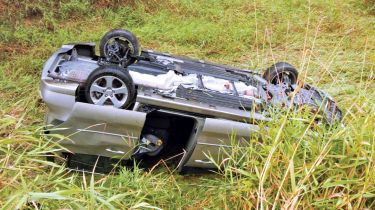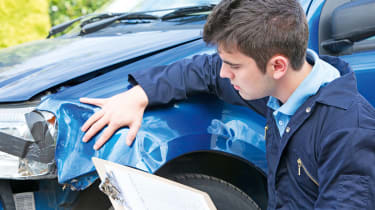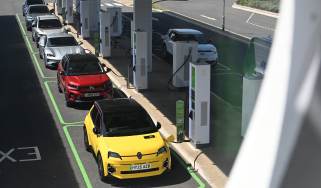What are Cat N and Cat S cars? Car insurance write-off categories explained
If a car is written off by the insurance provider, it could be assigned Category A, B, S or N status, but what does this mean and how do write-off classifications work?

If you’re looking to buy a used car, chances are you might come across an example which is labelled as ‘Cat S’ or ‘Cat N’ and is often much cheaper than the other listings. That’s because Cat S and Cat N cars have been declared as insurance write-offs.
Depending on the age of the vehicle, there are four insurance write-off categories that could be assigned to a car as a result of a collision or incident, and each is an indicator of the severity of the damage inflicted.
Don’t worry, though, as not all cars written off by insurers are unsafe or destined for the scrap yard. This guide will walk you through each car insurance write-off category, what to look out for if you’re buying a used car which has been written off, and what to do if your car is written off.
What is an insurance write-off?
A car is declared a write-off by the car insurance provider when either: the cost to repair is higher than the overall value of the car, or the vehicle is so badly damaged that it would be unsafe to repair and return to the road.
There are lots of reasons why a car might be declared an insurance write-off, with the most common being damage caused by:
- Major road collisions
- Incidents such as a fires, floods, vandalism or theft
Car insurance write-off categories at a glance
If you’ve been involved in an accident and inform your car insurance provider, they will send someone to assess the damage.
Depending on the amount of damage caused, the assessor will assign the car with a write-off category which indicates the severity of the damage caused and the nature of any repairs required to make it roadworthy again.
There are four different insurance write-off categories, each one represented by a letter indicating the severity of the damage:
- A: Scrap, car is beyond salvation and must be crushed immediately
- B: Break, car cannot be safely repaired but usable parts may be salvaged
- S: Structural damage, repairable
- N: Non-structural damage, repairable
You cannot attempt to repair or even resell a Cat A or B car as it is both dangerous and illegal.
Cars designated as Cat N or S can be repaired, returned to the road and even sold on the used market.
What is a Cat N car?

A Cat N, or Category N, insurance write-off is a car which has been written-off by the insurance company due to non-structural damage to elements such as body panels, lights and electrical systems deemed too expensive or uneconomical to repair .
Cat N vehicles can legally be put back on the road, but the Driver and Vehicle Licensing Agency (DVLA) must be informed that a car has been written off in the first place.
If you are selling a Category N car, you must inform any potential seller that the car has been declared a Cat N write-off at some point in the past.
What is a Cat S car?
A Cat S, or Category S, insurance write-off refers to a vehicle which has sustained structural damage.
This applies to areas that are integral to the car's structure such as the chassis and suspension, but the damage sustained is deemed repairable.
While Cat S cars can safely and legally be repaired and put back on the road, they must be re-registered with the DVLA beforehand.
What to look out for when buying a Cat S car
Structural damage can be much more difficult to spot than cosmetic damage, as it will probably be obscured by a body panel which may have been replaced.
If you are considering buying a Cat S car, we recommend paying for a professional inspection before any money changes hands, as a disreputable seller may try to hide any poor or non-existent repairs.
What is a Cat A or Cat B car?
If a car is damaged beyond the point that an insurer believes it can be safely returned to the road, it will be classified as either Cat A or Cat B.
- Cat A cars have been damaged so severely that they have to be crushed, and none of their parts can ever legally be reused or sold on.
- Cat B cars have also sustained a significant amount of damage, meaning that the shell and chassis of the car has to be crushed. However, the ‘B’ stands for ‘break’, so the car can be broken up for parts before that happens. Salvageable components can then be resold.
You shouldn’t ever see either of these categories in the used car classifieds, but if a background check reveals that a car is either a Cat A or Cat B write-off, walk away immediately.
What are Cat C or Cat D cars?
In 2017, Cat N and Cat S replaced the older Cat C and Cat D categories to help better represent the complexity involved in repairing modern cars.
If you are searching for a used car, it is important to note that old cars which were originally assessed through the old system prior to October 2017 won’t be reassessed, so they may still have Cat C or D classifications.
We also have a detailed guide to the old Cat C and Cat D write-off categories…
What to do if your car is written off
If you’ve been involved in an accident and your car has been severely damaged, your insurer will declare it as a write-off if the cost of repair outweighs the value of the vehicle.
If your insurance provider decides that the vehicle is to be repaired or scrapped, they will make all the necessary arrangements for your car to be collected and sent for repair, or to the scrapyard.
While this experience isn’t the most pleasant, following the steps below will help the process run smoother:
Inform the DVLA
You need to inform the DVLA that your car has been written off. This can be done via the GOV.UK website, and you’ll need to provide:
- The vehicle’s registration number
- The name and postcode of your car insurance provider
- The 11-digit reference number from the yellow ‘sell, transfer or part-exchange your vehicle to the motortrade’ section of your V5C log book
Failing to inform the DVLA could result in a fine of up to £1,000.
Remove your private registration
If you have a private registration number, ask to have this removed from the vehicle. If this doesn’t apply to you, you can skip this step.
We cover how to transfer a private number plate here...
Fill out the correct part of your V5C logbook
If your car is declared a Cat S insurance write-off, you will need to send your V5C log book to the DVLA.
Simply, remove the yellow ‘sell, transfer or part-exchange your vehicle to the motor trade’ section from your vehicle’s V5C logbook and keep this for your records, then send the rest of the document to your insurance company.
You can then apply for a new, duplicate log book for free by filling out a V62 form.
If your car is declared as Cat N, you do not need to fill anything out and can keep your current log book, but you still need to inform the DVLA.
Should I buy a Cat S or Cat N car?

Should you buy a Cat S or Cat N car? The answer is 'maybe'.
If you’re considering buying a Cat S or Cat N car, the same golden used car buying rule applies: buyer beware.
A Cat S or Cat N car that has been repaired to a very high standard could prove to be a cost-effective purchase, but thorough research and caution are essential as every car is different.
These are the most important things to consider:
- History: Conducting a complete background check on a car should show whether it has ever been declared as a write-off. You can also check the V5C vehicle log book for the ‘S’ mark. Some dodgy sellers may try to pass off a Cat N or Cat S car as non-damaged, despite being legally required to inform a potential buyer of the car’s correct write-off status. If you know or even just suspect that a seller is hiding something, do not take a gamble, simply walk away.
- Repairs: Once you have determined a car’s history, it’s important to be sure of the standard of all repairs carried out when the car was returned to the road. If you are viewing a potential write-off purchase, it is a very good idea to get a professional inspection before signing any paperwork or parting with any money — this is particularly important with structurally damaged Cat S cars.
- Insurance: Another thing to be aware of is that insurance can be harder to come by for previously written off cars, with some providers not covering them at all. While this can be overcome by hunting around, insurance for Cat S and N cars — likewise for older Cat C and D — tends to be more expensive than it is for non-written-off cars.
- Value: Written-off cars are also worth less than their undamaged counterparts. While this should be reflected in their purchase price, you may find it hard to sell a Cat S or Cat N car, as some buyers simply won’t consider them.
How much is a Cat S or Cat N car worth?
If a car is written off, this can have a big impact on its value. Some used car buyers won’t even consider touching a Cat S or Cat N, while others would only look at buying if there is a big reduction in price.
Valuing a car is a difficult task in general, and that’s before you bring a write-off into the equation. Factors such as age, fuel type, mileage, colour and condition can all influence a car’s value. Older cars which have been written off could be a few hundreds pounds cheaper than the normal market value, while newer cars could see a difference of thousands of pounds.
How much is your car worth? Find out with our free car valuation tool...
What does Cat S and Cat N damage mean for buyers?
The write-off categories are intended to reflect the type of damage sustained by a car that caused it to be written off. Knowing this information will go some way towards helping any potential future buyers understand what to look for when inspecting a potential purchase.
Knowing that a car was previously structurally damaged is particularly important, as poor repairs can be easier to hide from all but the most thorough of inspections. These can then quickly become very costly or even downright dangerous.
All sellers, whether trade or private, are required to declare if a vehicle has been previously written off at any time. However, there are some dishonest people out there, so conducting a background check, such as those undertaken by Hire Purchase Investigation (HPI), should reveal this categorisation as an alert on the car’s history. The registration certificate, known as the V5C, will also be marked with an ‘S’ to signify that the car has been salvaged.
Did you know you can sell your car through Auto Express? We’ll help you get a great price and find a great deal on a new car, too.
Frequently Asked Questions
When a car is written off by an insurer, it has been deemed as uneconomical to repair. If this happens, the car will be retained by the insurer and the owner will receive a payout. The severity of the damage will determine the car’s allocated write-off category, and ultimately whether or not it can legally be repaired and returned to the road in future.
Find a car with the experts








